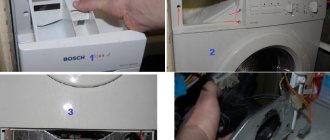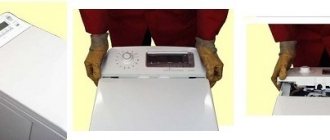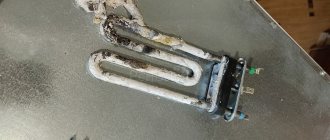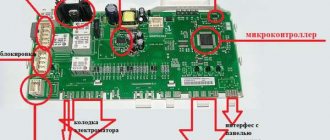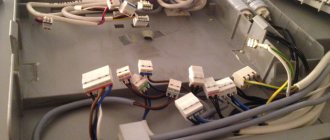The devices responsible for ensuring that everything works smoothly are control elements represented by electronic units and sensors. One of the most important parts of any washing unit is the pressure switch.
If the water level sensor is faulty, the control module of the washing machine processes the signal incorrectly or does not receive it at all from this device. In such a situation, the water level in the tank is not controlled, and therefore underfilling or overflowing occurs. All signs of a malfunction of this sensor will be described below.
What is a pressure switch
When wondering what a water level sensor is, you need to understand that any process related to the supply of water to the washing unit must be strictly regulated by a given program. According to the principle of operation, the pressure switches of washing machines Lg, Samsung, Electrolux, Candy, Ariston or any other brands do not differ, but there may be differences in design, appearance and characteristics. This device looks like a small plastic piece, usually round in shape, with electrical wiring connected to it and a tube from the washing tub tank.
The pressure switch in a washing machine is a device that controls the water level in the tank, without which the operation of any unit is simply impossible. The element is small in size, and its replacement does not require major capital investments, but the importance of this part is enormous.
What is this?
Such a part as a pressure switch is found in any automatic washing machine, be it Electrolux, Samsung, Indesit, Zanussi, Ariston, Candy or any other manufacturer. The main function of this element in a washing machine is to determine the presence of water in the tank and its level. That is why the second common name for such a part is “water level sensor”.
In the absence of a pressure switch, the control module of the device would not be able to determine whether water is being filled into the tank and how much of it is already inside the machine. In addition, different programs require different amounts of water, which should also be regulated by a pressure switch.
The sensor itself is a small round plastic piece to which wires are connected. Also, a tube from the high-pressure tank is connected to the pressure switch.
The principle of operation of the pressure switch is that after collecting water in a given tank, the pressure increases, which is an incentive to close or open the contacts in the relay.
Operating principle of the sensor
The operating principle of the water level switch of a washing machine is based on the effect of pressure on a special membrane (diaphragm). When water is drawn into the tank of the washing unit, water fills the compression chamber and pressure corresponding to the level of the collected water is injected into the sensor housing through a special tube.
The compression chamber is usually built into the drain pipe. The pipe itself is connected to the tank and the volute from the drain pump using special clamps. There are cameras soldered directly into the tank itself. It happens that these cameras become clogged with slurry and dirt over time!
When pressure is applied to the membrane, the contacts close and open, as a result of which a signal about incoming water is sent to the control module. There are several types of pressure switch: pneumatic (mechanical) or with an oscillating circuit (electronic), in this case the mechanical principle will be described. They are also divided into single-chamber and double-chamber.
Double-chamber pressure sensors are specially developed for washing machines with small and large loads. When the load is low, one membrane is activated and water is supplied in a minimum amount. When the drum is heavily loaded, the second membrane is activated, the contacts close and the control processor gives a command to supply the maximum amount of water.
As a rule, the membrane installed inside the sensor is made of rubber or elastic polymer and is designed for repeated on and off cycles. The operating principle of the pressure switch combines the sequential influence of air pressure on the mechanical part, above which the electrical contacts are located, and a direct electrical impulse on the control processor of the washing unit.
Signs of a malfunctioning pressure switch
As with any element of a washing unit, malfunctions can occur in the water level sensor, leading to malfunctions of the entire washing unit. This is expressed in the following signs:
- the washing process begins in the absence of water;
- water is supplied to the tank in too much or too little quantity;
- after the wash is completed, water is not removed from the tank;
- the laundry spinning program is not processed;
- There is a periodic pumping out of dirty water and supply of clean water in the rinsing mode, which is not typical for normal operation;
- malfunctions of the washing machine in all washing programs.
In addition, due to the lack of water in the tank and the heating element being turned on, smoke and a burning smell may appear. Typically, such inclusion ends with the replacement of the heating element. A faulty sensor can also lead to failure of the electric motor due to constant overload on it, since more water is often drawn into the tank than the required level.
Symptoms of a problem
If the pressure sensor fails, an error code will be displayed on the display of modern washing machines (each manufacturer has its own error, look in the operating instructions). But damage can also be determined by other signs.
Water does not fill
After selecting a washing program and turning on the machine, water does not fill, but the wash starts. This happens when the contacts of the device stick in the “full” position, and the programmer automatically starts the “dry” washing process.
Repeating cycles multiple times (endless wash)
Due to a breakdown, the sensor stops functioning or does not work correctly, transmitting incorrect commands to the control panel. It is necessary to disconnect the machine from the network and replace the pressure switch.
Poor wash quality
If the sensor is adjusted to low pressure (or the membrane has become stuck due to age), then the water in the tank will not be enough to thoroughly wash dirty clothes. In this case, tighten the spring with the adjusting screw.
Water remains in the machine
There are several reasons why water remains in the drum, including a malfunction of the pressure switch or related elements. Sometimes after finishing the wash, not all the water is drained and new water immediately begins to accumulate. If all the hoses are clean and the drain pump is working correctly, the problem is in the pressure switch.
The smell of burning
The lack of water in the washing machine and the appearance of a burning smell indicates a malfunction of the sensor or problems with the pump. The programmer starts the washing process, the heating element begins to heat up, but since there is no water, the fuse of the heating device trips, which is why the smell appears.
Where is the pressure switch located?
In washing machines from most manufacturers, the sensor is installed on a bracket in the upper part of the body on the side wall, however, in each specific case, you can find out where this device is located only by removing the top cover or side trim of the unit. Very rarely, on vertical types of machines, the pressure switch is located at the bottom of the unit.
A distinctive feature that makes it easy to find the sensor is a small-diameter tube connected to it, usually made of rubber or polyvinyl chloride.
Checking for serviceability
If you suspect that the water level sensor is not functioning, do not rush to immediately replace it with a new one. First, check whether the pressure switch is actually faulty. To do this, remove the part from the machine, previously disconnected from the network. Usually this sensor is located on the side wall of the device closer to its top. So your first action should be to detach the top cover.
After unscrewing the bolts that hold it in place, slide the cover away from you and remove it. The sensor is secured with 1-2 bolts, which you will have to unscrew. You also need to disconnect the contacts and hose from the pressure switch by unscrewing its clamp using pliers.
After this, we check the sensor using a hose about 10 centimeters long, the diameter of which should be the same as that of the tube removed from the pressure switch. Place one end of this hose on the inlet fitting, and blow on the other end, applying the pressure switch to your ear. You should hear several clicks (one to three depending on your washing machine) indicating that the sensor is working. If there is silence inside the pressure switch, it means it is not working.
You can also use a multimeter to check the conductivity. For a working pressure switch, it will change as the air pressure increases.
Related article: Do-it-yourself high-quality furniture made from panels
You can clearly see the process of checking the pressure switch for functionality in the following video.
Replacing the pressure switch
If checking the water level switch shows that it is faulty, then replacing it in most cases does not cause any particular difficulties. Therefore, you can change this device yourself, without resorting to the help of specialists. Repairing the device itself is not only impractical, but also useless, since the case is non-separable, any attempt to get to the internal parts will lead to a violation of its integrity. Some types of water pressure sensors must be opened, but this is a rather lengthy process and requires some competence in this area.
Replacing the pressure switch in a washing machine begins with disconnecting the vacuum tube and electrical contacts. By loosening or unscrewing the mounting bolts, remove the sensor. Reinstallation of the device is carried out in the reverse order of dismantling. Although the vast majority of sensors are similar in appearance, it must be taken into account that this element is configured for a specific model and brand of washing unit.
When carrying out all types of work, safety measures must be strictly observed. Before starting work, it is imperative to disconnect the plug of the washing unit from the power outlet.
Adjustment
The volume of water poured into the machine is regulated by two screws on the sensor body. The first screw, which is installed in the center, is responsible for connecting the contacts, the second is for breaking the electrical circuit. Depending on the model of the washing machine, the number of contact groups may vary - this is due to the fact that different variations of machines have their own set of washing programs.
Washing modes are set to a certain amount of water, and it is different in each program . For example, in the “Cotton” and “Quick Wash” modes, the volume of water poured into the tank differs noticeably. Correct setup is carried out by production specialists. They fix the position of the screws with varnish or paint.
It is not recommended to change the position of the screws yourself; this can lead to malfunction of the machine and failure of the washing programs. To adjust the adjusting screws yourself, you need to know exactly how much water is required in all modes at each stage of washing. According to this principle, the moments of switching on and disconnecting contacts are established.
The video will tell you about the pressure switch of the washing machine:
How to check the pressure switch yourself
The water level sensor in the washing machine tank can be checked for functionality at home. To do this, it must be dismantled. Carefully inspect the pressure switch housing and vacuum tube for mechanical damage (cracks, chips, abrasions). Carefully check the tube and inlet fitting for blockages, and if there are any, clean them with a plastic stick or soft wire.
The pressure switch can be checked for functionality by blowing air into its housing using a small hose identical in diameter to the standard one. To do this, attach the hose to the inlet fitting and blow lightly into it several times. In connection with the pressure force, characteristic clicks should be heard inside the housing. The number of clicks depends on how many water levels a particular model of washing unit provides. Their absence indicates a malfunction.
The second way to check the water level sensor is to measure it with a multimeter. This method allows you to be almost one hundred percent sure that the pressure switch is faulty. By connecting the device to the pressure switch, you need to measure the resistance. If the resistance does not change when air is blown into the device body, you can safely send the faulty element for scrap.
In order to avoid undesirable consequences for the entire washing unit as a whole, it is necessary to carefully monitor its operation, and if the slightest malfunction is detected, take the necessary measures. By replacing a relatively inexpensive pressure switch in advance, you can extend the life of the entire washing machine for a long time.
Settings
For the level sensor to work correctly, it must be configured, but this is not the concern of the owner of the washing machine, but the manufacturer, since the setting is carried out and checked in production. However, there are situations when the owner of the equipment wants to change the pressure switch settings. This can be done by tightening the adjusting screws on the part.
Related article: How to seal cracks between logs - choosing the best caulking method
Setting the washing machine pressure switch
Along with the serviceability of all elements of the sensor, its precise adjustment is also of utmost importance. It must operate clearly at certain pressure levels, sending the necessary signals to the central control processor. The amount of water supplied to the tank depends on this, which is different at each stage of washing.
Accurate calibration of pressure switches is carried out at the manufacturer's factory using special ohmmeter devices, and under normal conditions no additional adjustment is required. Washing machine repair technicians not only do not recommend, but also categorically deny the possibility of adjusting the pressure sensor at home.
On the adjusting bolt of almost any pressure switch there is a seal, the integrity of which must not be violated. Even if you simply insert a screwdriver and turn the bolt half a turn, and then turn it the same half a turn in the opposite direction, the fine adjustment will be lost. In this case, no one can guarantee the normal operation of the washing unit.
Experiments with adjusting the water level sensor, as a rule, lead to failure of the heating element or the entire unit as a whole. If the cause of malfunctions in the washing machine is indeed the pressure switch, it is replaced entirely, and it is best if this operation is carried out by a service center technician, followed by high-quality diagnostics.
Setting up the pressure switch
To set the optimal water flow when operating the washing machine, the pressure switch must be adjusted. The adjustment is usually performed by the manufacturer, but the same steps can be performed independently after replacing the sensor.
The pressure switch has adjusting screws that need to be turned half a turn. In this case, the washing machine should not be connected to the network, and the water should be turned off. After each turn, you should replace the cap and check the amount of liquid being poured. When the optimal level is reached, the adjustment can be completed. It is recommended to secure the screws with a sealing substance so that they do not turn randomly when wrung out.
